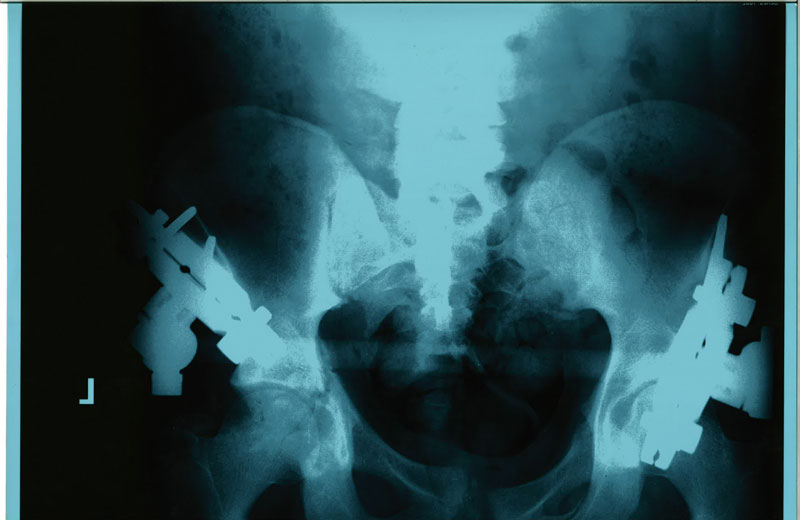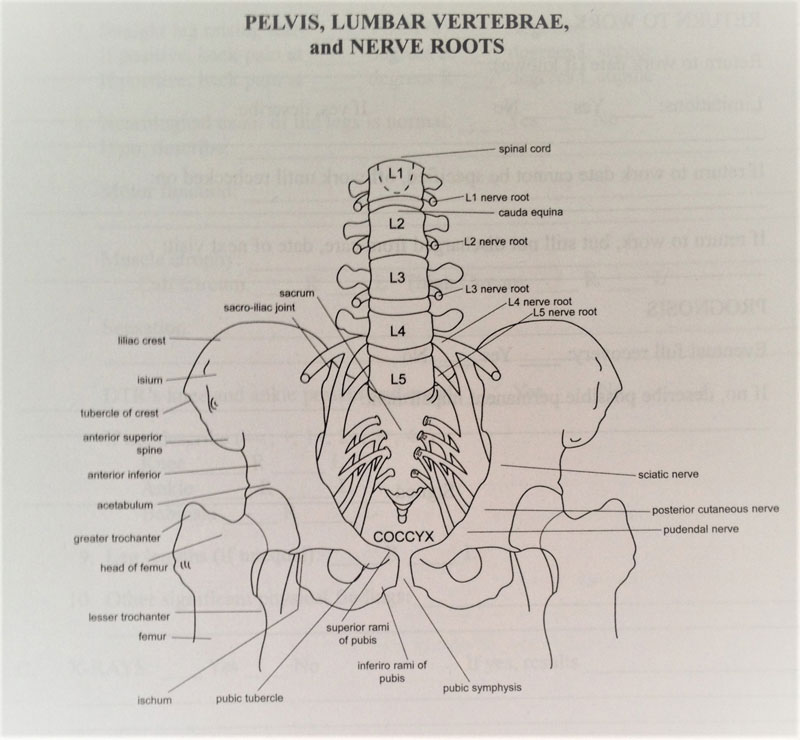This Page Teaches:
- Causes of a Pelvis Fracture / Broken Hip
- Pelvis Bones / Anatomy
- Types of Pelvis Fractures
- Hip Pain & Other Symptoms
- Dealing with a Lawsuit from a Broken Hip
Broken hip surgery and pelvic fracture victims are common clients for the Hip Fracture Lawyers at Hamilton & Associates. These broken hips and pelvic fractures often result from auto accidents. Pelvic fractures are serious events as it takes extreme trauma or weakness to break the pelvis.
Special legal issues arise with pelvic fractures. This is because a pelvic fracture is not seen from the outside; rather, it may heal but leaves extreme disability, pain, and limitations. The first legal issue with a pelvic fracture is the defendant’s allegation that the pelvic fracture is due to osteoporosis, wear, tear, age, or some other cause other than the accident. Broken bone attorneys have relationships with orthopedic experts to overcome such false allegations and show the jury the truth; that the accident did indeed cause the pelvic fracture.
The second legal issue with a pelvic fracture is proving the long term necessary treatment, disability, pain, and limitations. A pelvic fracture is not visible, like a burn, or other obvious injury. Pelvic fractures can be difficult to quantify the level of their disability and resulting case-value from a long term chronic standpoint. Defendants will argue that the future is speculative and unfounded. The targeted experience of broken bone attorneys can get this into evidence to provide full value for a pelvic fracture.
What Are the Causes of Pelvic Fractures?
The pelvis is a very strong bone. Nature designed it to hold up under extreme duress. Most pelvic fractures result from the following causes.
- A crush accident
- A fall from a high height
- An auto accident
- Bone insufficiency (osteoporosis or other age and wear related ailments)
What Is the Anatomy of the Pelvis?
Your pelvis is your hip bone. It exists just below your spine and above your legs. It is comprised of three components:
- The Coccyx (tailbone)
- The Hip bone itself
- Your sacrum (the triangle at the base of your backbone)
There are three main bones of your pelvis. They are:
- The Pubis
- The Ischium
- The Illium
These three hip bone elements are separate as a child. As we age, they grow together and fuse.
What Are the Types of Pelvic Fractures?
There are three main types of pelvic injury. These are known as the Tile Classification or the Young-Burgess classification. Most physicians prefer the Young-Burgess System of classifying pelvis injury.
- Type A Pelvic Injury
These are stable bone breaks of the pelvis. They include pubic ramous fractures, single bone stable fractures and iliac wing bone breaks. Where muscle attaches to the pelvis it is known as an avulsion fracture. The three types of avulsion fractures are:- A Interior inferior iliac spine break
- B Interior superior iliac spine break
- C Ischial tuberosity break
- Type B Pelvic Injury
These are rotation related pelvis injuries. They are horizontally unstable but vertically stable, typically. Type B Pelvic injuries come in three categories:- B1= This is an “open book” break. These include antero-posterior compression fractures known as APC breaks.
- B2 = These are isolateral compression fractures of the pelvis
- B3 = These are compression fractures that are contralateral. They include pubic rami breaks (on one side of the pelvis) in sacroiliac (SI) breaks.
- Type C Pelvic Fractures
These are unstable both horizontally and vertically. They involve complete disruption of the pelvis and the pelvic ring. They are often displaced and separated at multiple points. These are highly dangerous traumatic injuries that can cause death from blood loss.There are three subdivisions of type C pelvic breaks.- C1 = Unilateral
- C2 = Bilateral
- C3 = Acetabular
Young Burgess Classification of Pelvis Fractures
There are three types of Young Burgess pelvis breaks. They are as follows:
- Type 1 = widening of the pelvis in excess of 2.5 centimeters with lateral compression of the pubic ramus and Ipsilateral interior sacral break.
- Type 2 = a disruption of the sacrospinous and sacrotuberous ligaments. They include ramus fractures and ilium fractures.
- Type 3 = dislocation of the blood flow. These vascular injuries also exhibit compression and contralateral anterior posterior compression breaks.
Stability of Pelvis Fractures: Stable vs. Unstable
There are stable and unstable pelvis fractures. A stable break of the hip will usually only involve one break of the bone and is a lower energy accident involving the iliac wing, the sacrum, or the inferior pubic ramus.
Unstable hip breaks typically involve multiple breaks in the pelvis. These are often displaced bone breaks where fragments do not line up and require intervention. Unstable pelvic fractures typically result from high speed accidents such as automobiles or falls from very large heights.


Open vs. Closed Hip Fractures
There can be open hip fractures or closed hip fractures. The distinction is whether your hip bone is sticking out of your skin. It goes without saying that an open hip fracture is a very serious injury indeed.
Diagnosis of Pelvic Fractures
Your treating physician will immediately want to stabilize any hip injury that is causing extreme pain. All pelvic fractures cause extreme pain. The treating physician may employ a number of techniques to diagnose a hip fracture. These include:
- A clinical examination (physically looking and touching you)
- An interview (asking you questions as how and where and what flavor you feel)
- X-rays
- CT Scans (computed tomography) a.k.a. CAT Scans
- MRI Scans (magnetic residence imaging
Treatment of a Pelvic Fracture: Surgical vs. Non-Surgical
There are many ways in which a physician may treat a broken hip. These can be non-surgical. For example; walking aids, prescription and over the counter medications, and rest and physical therapy can be prescribed.
Surgical treatment may also be necessary to fix a broken pelvis. There are three types of surgeries usually performed:
- External fixation = applying metal pins and screws to your skin and through the muscle into and fixing against the interior of the pelvis. This creates a framework to hold your broken pelvis parts in alignment for healing.
- Skeletal traction = a system of weights, counterweights, and pulleys that put the piece of bones in proper alignment during the healing process. Metal pins and screws maybe implanted through your legs to help with positioning with them.
- R.I.F. = open reduction and internal fixation. This is an operation were the shattered bone fragment are positioned and then screwed into place with metal plates.
Symptoms of a Pelvic Fracture
There are a number of symptoms that may cause a physician concern that a pelvis fracture has occurred. These include:
- Incontinence
- Losing consciousness
- Going into shock
- Blood in one’s urine
- Swelling around your mid-section
- Extreme pain in the hip or legs
- Inability to ambulate
- Bruising around the mid-section
- Paralysis in the legs
- Weakness in legs
- Losing control of one’s bowels
Long -Term Ramifications from Pelvic Fractures
The future of the patient for the broken pelvis is entirely dependent upon the severity of the initial broken hip. This is then complicated by the pre-existing health of the victim, the competence of the treating physicians, and the degree of participation in the healing process by the patient.
Pelvic fractures can be deadly if blood loss is not stopped. Some types of broken pelvis cases have deaths exceeding 40% of all patients. However, a stable pelvis fractures typically heal nicely.
Complications can include:
- Blood loss
- Damage to surrounding organs
- Bacterial infection
- Venous thrombosis
- Embolism
Patients that have suffered an acetabular fracture (around a joint) should expect long term arthritis and difficulty moving. These almost always involve the loss of the ability to function, and due daily activities to one degree or another.
Compensation for Broken Pelvis Accidents
Victims of a pelvic fracture should contact broken bones attorneys, such as those at Hamilton and Associates. We will go over the specific facts of the case. This will allow us to estimate the likelihood of success and the value of the case. Early investigation will approve the accuracy in and likelihood of a good result. The largest single feature of the pelvis fracture is to hire an attorney with targeted experience in the field so that full compensation can be realized because of the complex nature of the pelvis fracture.
